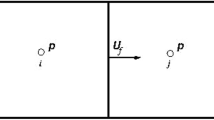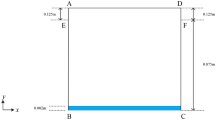Conclusions
-
1.
The finite-element method may be successfully and effectively used in solving problems regarding the strength and stability of sloping and nonsloping shells and plates. The rejection of the simplifying hypotheses made in the theory of shells and also the allowance made for the rigid displacement of the body enables the results of the theory of thin plates and shells to be refined, the limits of its applicability to be established, and a faster convergence of the results to be achieved as compared with other versions of the finite-element method.
-
2.
The algorithm employed for the solution of geometrically nonlinear problems offers the possibility of studying the hypercritical behavior of sloping and nonsloping shells in the best possible way.
-
3.
The version of the MSFE here described may also be used in solving physically nonlinear problems and problems regarding the dynamics of plates and shells.
Similar content being viewed by others
Literature Cited
A. S. Sakharov, “Moment scheme of finite elements (MSFE) allowing for rigid displacements,” in: Resistance of Materials and the Theory of Buildings [in Russian], No. 24 (1974), pp. 147–156.
V. N. Kislookii, A. D. Legostaev, A. S. Sakharov, and N. A. Solovei, “One version of the method of finite elements in problems regarding the statics and dynamics of cantilever shells,” in: Resistance of Materials and the Theory of Buildings [in Russian], No. 26 (1975), pp. 45–51.
I. E. Goncharenko, A. D. Legostaev, and N. A. Solovei, “Study of the stressed state of nonsloping shells of complex configurations in the linear formulation,” in: Organization and method of Building Design using Computing and Organizational Technology [in Russian], No. 2 (1974), pp. 11–16.
O. K. Zenkevich, Method of Finite Elements in Technology [Russian translation], Mir, Moscow (1975).
D. J. Olman, “Triangular finite elements for calculating bendable plates for constant and linearly distributed bending moments,” in: Calculation of Elastic Constructions Using Electronic Computers [Russian translation], Vol. 1, Leningrad (1974), pp. 80–101.
P. S. Timoshenko and Voinovskii-Kriger, Plates and Shells [Russian translation], Nauka, Moscow (1966).
A. A. Nazarov, Foundations of the Theory and Method of Calculating Sloping Shells [in Russian], State Press for Technical and Theoretical Literature, Leningrad-Moscow (1966).
V. I. Gulyaev and G. I. Mel'nichenko, “Hypercritical states of rectangular cylindrical panels,” in: Resistance of Materials and Theory of Buildings [in Russian], No. 27 (1974), pp. 10–18.
A. S. Vol'mir, Stability of Elastic Systems [in Russian], Fizmatgiz, Moscow (1963).
V. V. Amel'chenko, I. V. Neverov, and V. V. Petrov, “Solution of nonlinear problems in the theory of sloping shells by variational iterations,” Mekh. Tverd. Tela, No. 3, 62–68 (1969).
Additional information
Kiev Institute of Building Engineers, Kiev. Translated from Problemy Prochnosti, No. 7, pp. 25–32, July, 1977.
Rights and permissions
About this article
Cite this article
Kislookii, V.N., Sakharov, A.S. & Solovei, N.A. Moment scheme of the finite-element method in geometrically nonlinear problems regarding the strength and stability of shells. Strength Mater 9, 808–817 (1977). https://doi.org/10.1007/BF01529016
Received:
Issue Date:
DOI: https://doi.org/10.1007/BF01529016




